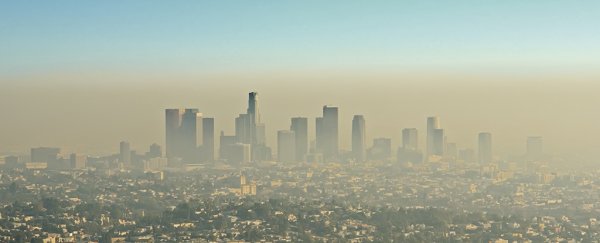How's the air in your neighbourhood today? A new State of Global Air report suggests more than 95 percent of the planet's population currently have to breathe polluted air – air containing fine particle levels that exceed the global air quality guidelines.
What's more, the burden of bad air quality is affecting the poorest communities the most. According to the US Health Effects Institute (HEI), which carried out the study, the gap between the most polluted and least polluted countries is steadily growing bigger.
This is having a real effect on health, too – an estimated 6.1 million deaths across the world in 2016 could be attributed to air pollution, the HEI reports. Strokes, heart attacks, lung cancer, and chronic lung disease were some of the health issues to blame.
That puts air pollution as the fourth highest deadly health risk on our planet – with only high blood pressure, diet, and smoking ahead of it.
"Air pollution takes a huge personal toll worldwide, making it difficult to breathe for those with respiratory disease, sending the young and old to hospital, missing school and work, and contributing to early death," says HEI Vice President Bob O'Keefe.
"The trends we report show real progress in some parts of the world – but serious challenges remain to eliminate this avoidable affliction."
Polluted air is defined by its concentration of ambient particulate matter (less than or equal to 2.5 micrometres in size), but for the first time the 2018 HEI study has included indoor air quality measurements as well as analysing outdoor readings.
This household air pollution – using coal, wood, and dung for cooking and heating inside the home – was responsible for 2.6 million deaths in 2016, the report states. That's almost half the total figure.
Ground measurements were combined with satellite readings and other data sources (including population density) to work out the numbers of people at risk. Other research like the Global Burden of Disease Study 2016 was also pulled in.
 Air pollution by region. (HEI)
Air pollution by region. (HEI)
The worst hit nations include those in North Africa, West Africa, and the Middle East, the report says, with both windblown mineral dust and solid fuel burning at home mainly responsible for the higher air pollution levels.
As the HEI report points out, many nations in Asia and Africa face a combination of both outdoor air pollution and indoor air pollution. With populations ageing as well, countries such as China and India are seeing more pollution-related deaths each year.
In contrast, countries that ranked the lowest for air pollution in the report included Australia, New Zealand, Canada, Finland, Iceland, and Sweden.
Particulate matter concentrations increased by 18 percent on average between 2010 and 2016, according to the HEI, although we are seeing improvements in certain areas – China has begun to stabilise pollution levels in recent years, for example.
If you want to check out all of this data for yourself, the HEI has put some interactive charts up on its website, so you can dig into the details for your part of the world.
Of course the big question is: what can we do about it? The HEI says the solutions will have to be wide-ranging, with the root causes of pollution – from busy urban transport networks, to household fuel burning, to wildfires – varying from place to place.
"Actions to reduce air pollution should address not only the larger-scale burning of coal by power plants and industries, but also the use of coal or different forms of biomass for heating and cooking in millions of small households around the world," says the report.
With some of the worst-affected cities on the planet facing serious disruption and dangers to public health, the challenge is growing. Last year China temporarily shut down up to 40 percent of its factories in an attempt to curb rising pollution levels.
What you may not have realised before is just how widespread the problem is, with only 5 percent of the planet enjoying air that meets international standards for quality. That's something that has to change.
"The Global Burden of Disease leads a growing worldwide consensus – among the WHO, World Bank, International Energy Agency and others – that air pollution poses a major global public health challenge," says HEI President Dan Greenbaum.
"Nowhere is that risk more evident than in the developing world, where a third of the world's population faces a double burden of indoor and outdoor air pollution."
You can read the State of Global Air report on the HEI website.
